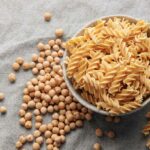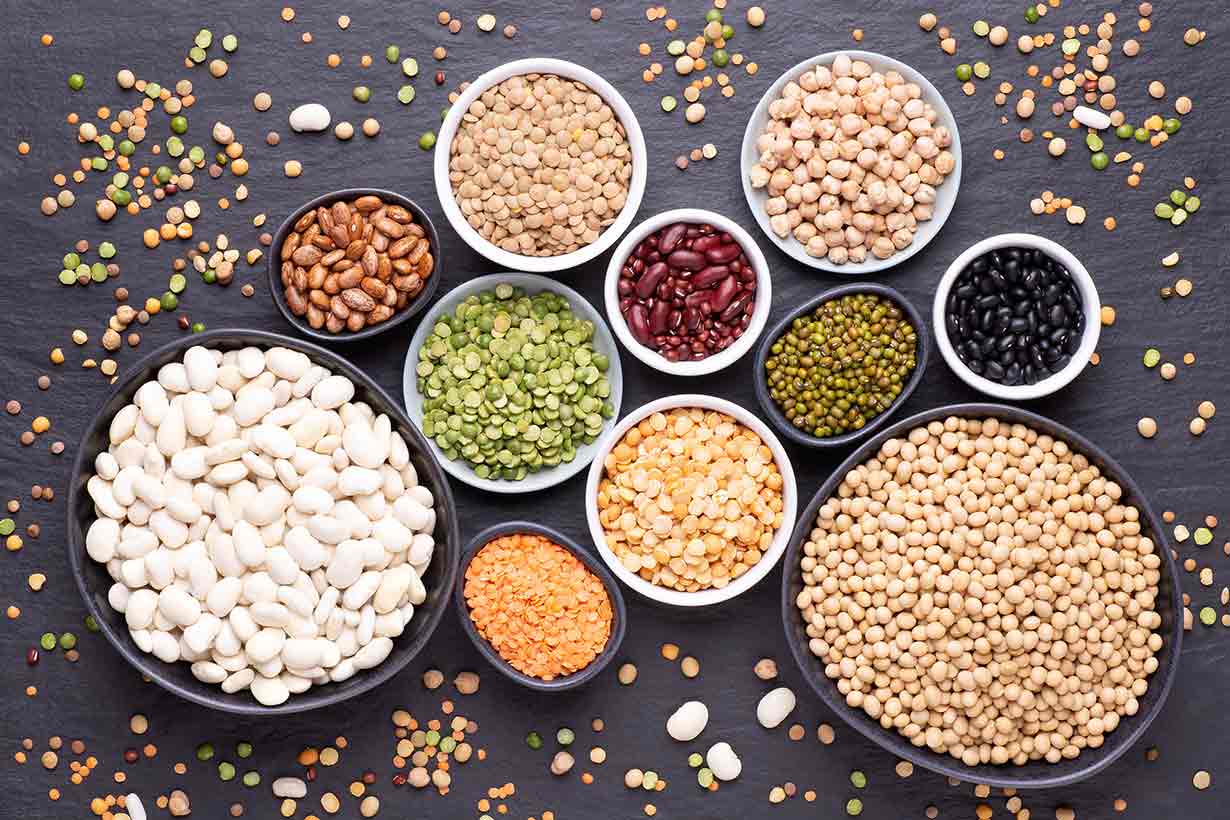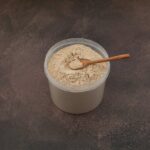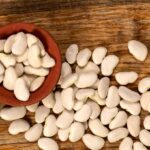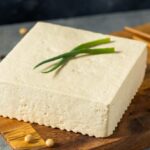Edamame pasta is one of several legume-based pasta products.
But what does it offer nutritionally, and how does it compare to regular pasta?
This article provides a complete guide to edamame pasta’s nutritional values and potential benefits.
Table of contents
What Is Edamame Pasta?

Edamame pasta takes the same form as regular pasta but has a different primary ingredient: edamame flour.
Like regular pasta, edamame pasta is available in numerous different-shaped varieties, from edamame noodles to edamame lasagna sheets and more.
As we can see in the above image, it looks just like wheat pasta but has a slight olive-green color.
Edamame pasta is an excellent plant-based protein source, rich in fiber, and provides a broad range of essential nutrients.
Ingredients
Edamame pasta has just one ingredient: edamame flour.
The word edamame refers to immature soybeans (also sometimes known as green soybeans).
100% edamame pasta products should contain no other ingredients.
However, some pasta products may use various different flours. Therefore, it is always a good idea to check the product label to be sure of the ingredients.
Taste
Taste is subjective, and we all like different things, but edamame pasta doesn’t taste too far away from the flavor of wheat pasta. However, compared to wheat pasta, it has slightly nutty and earthy flavor tones.
It also has a grainier texture than wheat (white) pasta, similar to wholewheat pasta and other legume pasta varieties like black bean pasta, red lentil pasta and chickpea pasta.
Edamame pasta is firm and chewy, meaning that its characteristics are a lot more like traditional pasta than ‘pasta alternatives’ like zucchini noodles.
What Nutrients Does It Contain?
Here are the full nutritional values of cooked edamame pasta per 140-gram cup serving.
The source of this nutritional data is the NCC Food and Nutrient Database (1).
All daily values (% DV) have been calculated by using this data alongside the FDA’s daily values (2).
Nutrition Facts
| Name | Amount | % Daily Value |
|---|---|---|
| Calories | 156 kcal | |
| Carbohydrates | 18.47 g | 6.7% DV |
| Fiber | 11.54 g | 41.2% DV |
| Sugars | 5.11 g | |
| Fat | 3.11 g | 4.0% DV |
| Saturated fat | 0.45 g | 2.3% DV |
| Monounsaturated fat | 0.59 g | |
| Polyunsaturated fat | 1.58 g | |
| Omega-3 | 0.20 g | |
| Omega-6 | 1.37 g | |
| Protein | 21.28 g | 42.6% DV |
| Cholesterol | 0 mg | 0% DV |
Vitamin Content
| Name | Amount | % Daily Value |
|---|---|---|
| Choline | 79.8 mg | 14.5% DV |
| Folate, DFE | 126.85 mcg | 31.7% DV |
| Vitamin A, RAE | 1.05 mcg | 0.1% DV |
| Vitamin B1 (thiamin) | 0.36 mg | 30% DV |
| Vitamin B2 (riboflavin) | 0.17 mg | 13.1% DV |
| Vitamin B3 (niacin) | 1.25 mg | 7.8% DV |
| Vitamin B5 (pantothenic acid) | 0.73 mg | 14.6% DV |
| Vitamin B6 (pyridoxine) | 0.32 mg | 18.8% DV |
| Vitamin B12 (cobalamin) | 0 mcg | 0% DV |
| Vitamin C | 0 mg | 0% DV |
| Vitamin D | 0 mcg | 0% DV |
| Vitamin E | 0.24 mg | 1.6% DV |
| Vitamin K | 5.59 mcg | 4.7% DV |
Mineral Content
| Name | Amount | % Daily Value |
|---|---|---|
| Calcium | 124.22 mg | 9.6% DV |
| Copper | 1.26 mg | 140% DV |
| Iron | 6.22 mg | 35% DV |
| Magnesium | 143.77 mg | 34.2% DV |
| Manganese | 1.39 mg | 60.4% DV |
| Phosphorus | 285.18 mg | 22.8% DV |
| Potassium | 1,116.47 mg | 23.8% DV |
| Selenium | 11.42 mcg | 20.8% DV |
| Sodium | 7.34 mg | 0.3% DV |
| Zinc | 1.75 mg | 15.9% DV |
Benefits of Edamame Pasta
Here is an overview of some of edamame pasta’s benefits.
It Provides a Broad Range of Essential Nutrients
As we can see from the previous nutritional values, edamame pasta offers a lot of nutritional value:
- More than 21 grams of protein and 11 grams of fiber per cup serving
- Significant folate content
- Greater than 10% of the daily value per serving for the following vitamins: choline, folate, vitamins B1, B2, B6, and B6.
- More than 100% of the daily value of copper
- Greater than 20% of the daily value for the minerals iron, magnesium, manganese, phosphorus, potassium, selenium, zinc
Fewer Carbohydrates and Calories
Compared to regular pasta, edamame pasta contains fewer carbohydrates. As a result, an equivalent serving size of edamame pasta provides the same amount of food but with fewer calories.
Anyone looking to decrease their carbohydrate intake may also wish to consider edamame pasta.
Gluten-Free
Gluten is a protein found in wheat and wheat products, which include wheat pasta.
Some people cannot consume gluten-containing foods without experiencing adverse effects such as digestive problems. This can be due to an autoimmune disorder called celiac disease or general gluten sensitivity (3, 4).
For this reason, edamame pasta is an excellent gluten-free replacement option for regular pasta.
How Does Edamame Pasta Compare To Wheat Pasta?
As previously mentioned, edamame pasta is gluten-free, which is one key difference compared to wheat pasta.
We will now look at some other differences between the two.
Nutritional Content
To assess nutritional differences, the following table compares the total nutritional values of edamame pasta, white pasta (enriched), and wholewheat pasta. These values are per 100 grams cooked (1, 5, 6).
| Nutrient | Edamame Pasta | White Pasta | Wholewheat Pasta |
|---|---|---|---|
| Calories | 111 kcal | 158 kcal | 149 kcal |
| Carbohydrates | 13.19 g | 30.9 g | 30.1 g |
| Fiber | 8.24 g | 1.8 g | 3.9 g |
| Sugars | 3.65 g | 0.56 g | 0.75 g |
| Fat | 2.22 g | 0.93 g | 1.71 g |
| Saturated fat | 0.32 g | 0.18 g | 0.24 mg |
| Monounsaturated fat | 0.42 g | 0.13 g | 0.18 mg |
| Polyunsaturated fat | 1.13 g | 0.33 g | 0.57 mg |
| Omega-3 | 0.14 g | 0.02 g | 0.04 g |
| Omega-6 | 0.98 g | 0.30 g | 0.54 g |
| Protein | 15.20 g | 5.80 g | 5.99 g |
| Choline | 57.0 mg | 6.4 mg | 6.5 mg |
| Folate, DFE | 90.61 mcg | 73 mcg | 21 mcg |
| Vitamin A, RAE | 0.75 mcg | 0 mcg | 0 mcg |
| Vitamin B1 | 0.26 mg | 0.27 mg | 0.16 mg |
| Vitamin B2 | 0.12 mg | 0.14 mg | 0.10 mg |
| Vitamin B3 | 0.89 mg | 1.69 mg | 3.13 mg |
| Vitamin B5 | 0.52 mg | 0.11 mg | 0.27 mg |
| Vitamin B6 | 0.23 mg | 0.05 g | 0.09 mg |
| Vitamin B12 | 0 mcg | 0 mcg | 0 mcg |
| Vitamin C | 0 mg | 0 mg | 0 mg |
| Vitamin D | 0 mcg | 0 mcg | 0 mcg |
| Vitamin E | 0.17 mg | 0.06 mg | 0.23 mg |
| Vitamin K | 3.99 mcg | 0.5 mcg | 0.6 mcg |
| Calcium | 88.73 mg | 7 mg | 13 mg |
| Copper | 0.90 mg | 0.1 mg | 0.23 mg |
| Iron | 4.44 mg | 1.28 mg | 1.72 mg |
| Magnesium | 102.69 mg | 18 mg | 54 mg |
| Manganese | 0.99 mg | 0.32 mg | 1.32 mg |
| Phosphorus | 203.70 mg | 58 mg | 127 mg |
| Potassium | 797.48 mg | 44 mg | 96 mg |
| Selenium | 8.16 mcg | 26.4 mcg | 36.3 mg |
| Sodium | 5.24 mg | 1 mg | 4 mg |
| Zinc | 1.25 mg | 0.51 mg | 1.34 mg |
From this comparison, we can see that:
- Despite having higher fiber and protein content, Edamame pasta contains fewer calories and carbohydrates than wheat pasta. This makes edamame pasta a good alternative for people wishing to increase their fiber and protein intake.
- Compared to wheat and wholewheat pasta, edamame pasta has a higher content of most vitamins and minerals. One notable exemption to this is selenium, which is present in higher amounts in wheat pasta.
Glycemic Index
There is no research showing the glycemic index of edamame pasta. However, it contains significantly fewer carbohydrates than wheat pasta.
For this reason, it is reasonable to expect that edamame pasta has a lower glycemic index than regular pasta, so it likely has a smaller impact on blood sugar levels.
Potential Downsides
The only ingredient in edamame pasta is flour from edamame (immature soybeans). Since the product is 100% soy-based, edamame pasta is unsuitable for anyone with a soy allergy.
Based on a meta-analysis of European Union data on soy allergy which included clinical confirmation, it is thought that the prevalence of soy allergy is at least 0.3% of the population (7).
Aside from potential allergies, the only other downside of edamame pasta appears to be the price. Although still relatively affordable, it does consistently cost more than traditional pasta.
How To Use
We can use edamame pasta in a wide variety of ways. However, there is nothing unique about edamame pasta; it doesn’t have to be used differently from regular pasta.
To boil the pasta, follow these steps:
Time needed: 12 minutes
- Bring water to a boil
Add about a liter of water for every 100 grams of dried edamame pasta to a pan and bring it to a boil.
- Add the pasta
When the water is boiling, add the dried edamame pasta.
- Reduce heat and simmer
After adding the pasta, lower the heat and simmer for approximately five minutes. Add a minute extra if you prefer softer pasta, or cook for a minute less for a firmer finished pasta.
- Drain and serve
Once the pasta is ready, drain the water and use the pasta as you wish.
It is also possible to use edamame pasta for specific dishes such as lasagna (edamame pasta sheets are available) or spaghetti (edamame noodles). In addition, many edamame pasta recipes are available online.
Common Questions
Lastly, here are some common questions about edamame pasta to answer any potential remaining questions.
Edamame pasta offers a broad range of beneficial nutrients in higher amounts than regular pasta and for fewer calories. As a result, edamame pasta is a healthy pasta alternative.
Most low-carb dieters shun regular pasta due to its relatively high carbohydrate content, but is edamame pasta more suitable for such diets? With only 13 grams of carbohydrates per 100-gram serving (cooked), edamame pasta can undoubtedly fit into lower-carbohydrate diets, but it depends on the individual and their dietary aimsand preferences.
When cooked, edamame pasta provides 13 grams of carbohydrate per 100 grams and 18 grams per 140-gram cup.
Final Thoughts
Overall, edamame pasta offers a lot nutritionally.
It’s an excellent source of plant protein and fiber and contains substantial amounts of several essential vitamins and minerals.
It may be particularly beneficial as a nutritional upgrade from regular white pasta for those who enjoy eating pasta frequently.

